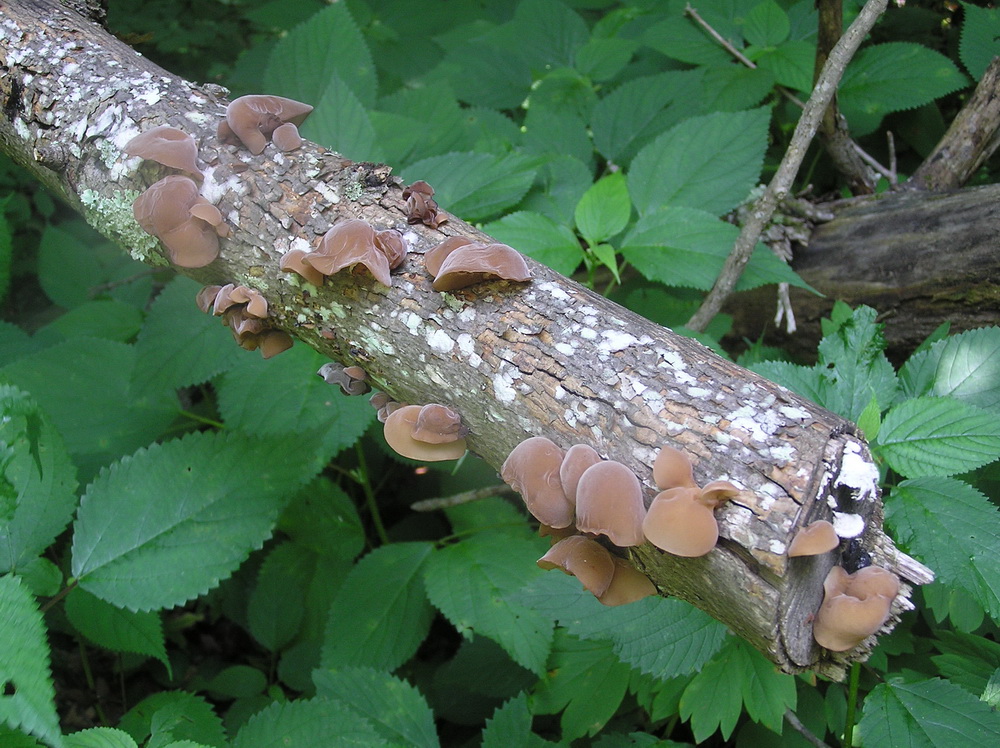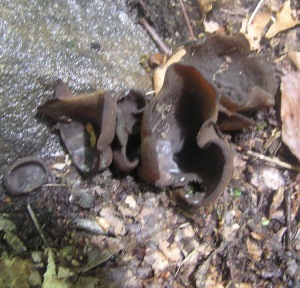
Common Name: Tree Ear, Wood Ear, Jelly Ear, Mu-erh or Mo-er (Chinese), Senji (Japanese) – The fungus grows from a single attachment and has the general bracket-cup shape and gelatinous texture of a human ear. It grows on trees, usually branches and not on the ground.
Scientific Name: Auricularia auricula – The Latin word for ear is auriculus; the use of this term for both the genus and the species would imply “ear-like” to express its appearance and “ear” to express its attachment at a single point. It is also frequently listed as and was originally called A. auricula-judae and has been accordingly called Jew’s ear or Judas’s ear due to this assignation.
Potpourri: The incongruous appearance of what looks to all intents and purposes to be an ear on a tree evidently caught the attention of hunter-gatherers throughout Eurasia at the dawn of human history. This is evident in the fact that Auricularia auricula and its hairier Asian cousin A. polytricha (Greek for many hairs) are listed in the earliest known general references on plants in both Europe and Asia. Global availability, facile recognition and pliable consistency apparently encouraged the adventurous (and probably chronically hungry) hominid to try it, perhaps judiciously at first. The taste and texture evidently encouraged some experimentation, resulting in what was undoubtedly a watershed moment in history when it became the first fungus in the historical record to be cultivated; this occurred about 600 CE during the Tang dynasty of China, preceding the first European discovery of mushroom cultivation of the Agaricus bisporus or, more appropriately, the champignon, in the caves around Paris, France in the 18th Century.

Auricularia auricula is a member of order Tremellales – more commonly known as the jelly fungi on account of the texture which can range from gelatinous to rubbery. Fruiting body shapes include everything from an amorphous mass like Witches’ Butter (Tremella mesenterica) to the rigidly lobed Tree ear. Jelly fungi are Basidiomycetes in spite of their verisimilitude to the Ascomycetes, or cup fungi. The Common Brown Cup (Peziza badio-confusa) is an ascomycete that is very similar in appearance to A. auricula; however, it only grows on the ground and has brittle flesh in contrast to the arboreal habitat and pliability of Tree Ear. The two main subphyla of the kingdom Fungi Basidiomycota and Ascomycota are distinguished according to their spore bearing structure, the former having a club-like four-spored basidia and the latter having a sac-like eight-spored ascus (from Greek askos meaning bladder). It is in the structure of the basidia that the jelly fungi are distinguished; whereas other basidiomycetes (all of the “mushrooms” except morels) have simple, tubular basidia, those of the Tremellales are either partitioned or forked.
It is not known when the anthropomorphic name Judas’s ear and its mildly pejorative derivative Jew’s ear was used for A. auriculus-judae, but its appearance in early European accounts suggests an ancient lineage. It is widely attested that the provenance of the name is the biblical account of Judas in Mathew 27 verse 5; after hearing of the condemnation of Jesus due to his betrayal, Judas “threw down the (thirty) pieces of silver in the temple and departed, and went and hanged himself.” There is no indication of that there was a specific tree involved, though numerous derivative sources identify the tree as an elder, one of the numerous trees that host the Tree Ear. Neither is the Judas association sui generis; the redbud tree (Cercis canadensis) is also known as the Judas tree due to its purported association with Dante’s most evil of villains – its white flowers changed to red buds as a sanguine reminder of this the penultimate betrayal of a friend. It should be noted that the elder is normally a mid-size shrub known for its elderberries and not a full sized tree from which anything might be hung. In my view, the name Judas’s ear and the condemnation of the elder tree for its complicit role is a matter of popular folk etiology in medieval Europe which was replete with religiosity and superstition before the advent of cultural sensitivities. The name stuck, though it is mercifully succumbing to desuetude.
More surprising than the Judean scriptural association of the Wood Ear was its accepted use as one of the earliest medicinal treatments. John Gerard is probably the most well-known of the European herbalists; his seminal work Herball or the General Historie of Plantes was a general botanical reference for the hundred years following its publication in 1597. The book is almost entirely devoted to plants with only passing reference to fungi, which were considered a type of plant (in the Subkingdom Thallophyta until about 1980). His overall view of mushrooms was in keeping with traditional Anglo-Saxon mycophobia: “…few of them are good to be eaten, and most of them do suffocate and strangle the eater. Therefore, I give my advice unto those that love strange and new-fangled meats, to beware of licking honey among thorns, lest the sweetness of the one do not countervail the sharpness and pricking of the other.” However, he found that the Wood Ear was an exception in noting that “The fungus excrescence of the Elder, commonly called a Jewes eare, is much used against the inflammations and all other soreness of the throat being boyled in milke, steeped in beere, vinegar, or any other convenient liquor.” This apparently was of such common knowledge that it appears in the text of one of the earliest English plays The Three Laws of Nature, Moses and Christ, corrupted by the Sodomytes, Pharisees and Papystes most wicked by John Bale in 1562 “For the coughs take Judas’s eare with a parynge of a peare.” This acceptance of an execrable fungus by an English herbalist may be due to the Doctrine of Signatures, a theory popularized as a Christian theology by Jacob Boehme in Signatura Rerum which translates as “The Signature of All Things.” Boehme claimed that plants of God’s Kingdom were given a characteristic appearance as a “sign” that was intentionally provided as a revelation. While one would think that a Wood ear would be good for something like earaches, it is not implausible that its folded lobes looked something like a throat, a view proffered by Tom Volk, the noted University of Wisconsin mycologist (he also compares the texture to Gummi Bears). As it turns out, it is actually good for a variety of things, perhaps even the throat (and ear).
Modern scientific research of the medicinal properties of both Auricularia auricula and its close cousin A. polytricha has revealed some significant potential for the treatment of a variety of ailments ranging from diabetes to cancer. Even the sore throat prescriptions of Gerard and Bale are to some extent vindicated; the Wood ear’s polysaccharides have an anti-inflammatory effect. A paper published in the journal Carbohydrate Research reported that the Beta-glucans and other branched polysaccharides of A. auricula-judae “exhibited potent, inhibitory activity against implanted Sarcoma 180 solid tumors in mice.” The hypoglycemic benefits are also well documented in a study published in the journal Bioscience, Biotechnology and Biochemistry showing that mice fed 30 grams of A. auricula-judae per kilogram of overall food ingested “had a significant effect on lowering plasma glucose, insulin, urinary glucose and food intake.” Perhaps the most profound effect is as an anticoagulant. The journal Thrombosis Research published a paper in 2003 on A. auricula which concluded that “The polysaccharides from these mushrooms may constitute a new source of compounds with action on coagulation, platelet aggregation and, perhaps, on thrombosis.” According to Paul Stamets in Growing Gourmet and Medicinal Mushrooms, the empirical evidence for the blood thinning properties of Wood ear have been clear for decades: “In the United States during the 1970’s, when Chinese restaurants started serving Wood Ear mushrooms, some patrons noted the emergence of blotchy hemorrhages on their faces the day after consumption. Caucasian women were particularly susceptible. This phenomenon was later dubbed Szechwan Restaurant Syndrome, later becoming known as Szechwan Purpura.” This rather curious assertion would certainly justify some dubiety as there has been no similar reported effect among Asians, though this could legitimately be an epidermal reaction that is pigment related. The overall effect of an aspirin-like platelet reduction, however, is well established. It was first documented in the New England Journal of Medicine in 1980 based on the report of a scientific researcher who found that “his platelets would not agglutinate or release serotonin on exposure to epinephrine” which he attributed to the consumption of Wood Ear mushrooms; this was confirmed experimentally on observation of the platelet diminution effect which ranged from 3 to 24 days on several volunteers. One may conclude that, while the claims of its carcinogenic and glycemic benefits to mice may not apply to humans, eating Tree Ear can do no harm and probably some good, particularly as a part of the balanced diet, as Mo-er is consumed in Asia.
Auricularia auricula that are gathered and A. polytricha that are cultivated for harvest taken together are among the most popular of edible fungi in the world, comprising about 8 percent of all mushroom production and ranking fourth among all species in 1997. This is almost entirely due to Asian market factors; the Wood Ear is a key ingredient in Chinese soups. They can readily be found in Asian markets in the desiccated state, which renders them dark brown as rather unappetizing looking chips. According to David Aurora in Mushrooms Demystified, they “billow up like clouds when soaked in water, showing off their delicate curves and convolutions to great effect.” This is the key to their place in the Asian cuisine; their profuse absorption of water includes the complex broth flavors that are imparted on rehydration. It is the texture of the Tree Ear fungi that beguiles, giving body to the otherwise fluid flavor. However, even the least discerning of western gourmands would only afford them faint praise. Charles McIlvaine may well qualify for that distinction; his prolific mycophagy extends to eating the Jack-O-Lantern Mushroom (Omphalotus olearius) that sickens others and is usually listed as poisonous. Of the Wood Ear, McIlvaine writes in One Thousand American Fungi that “the writer has found and eaten several specimens of it. It is not as tender as other gelatinous species, but it is an oddity that pleases.” Paul Stamets provides probably the most balanced characterization in noting that “for many this mushroom is not remarkably flavorful. Nevertheless this mushroom adds another dimension to the culinary experience … a most appealing brittle-gelatinous texture, potentiating the flavors of foods cooked with it.” It is worth noting that the Wood Ear, like most fungi, is quite nutritious: 100 grams of dried fungus yields about 10 grams of protein and an equal amount of fiber, the balance primarily carbohydrates, for a total caloric intake of 370 kcal. It should be noted that the Wood Ear is about 90 percent water, so 100 grams dry would be almost 2 pounds of harvested wood ear – enough to fill a good sized paper bag. One must conclude that the Wood Ear has compelling attributes: it offers health advancing compounds that suppress tumorous growth and impede stroke-inducing blood clots; it is high in fiber to promote intestinal composure; it is high in protein to support cell growth, and it is an interesting textural additive to almost anything. Soup is just the beginning.
